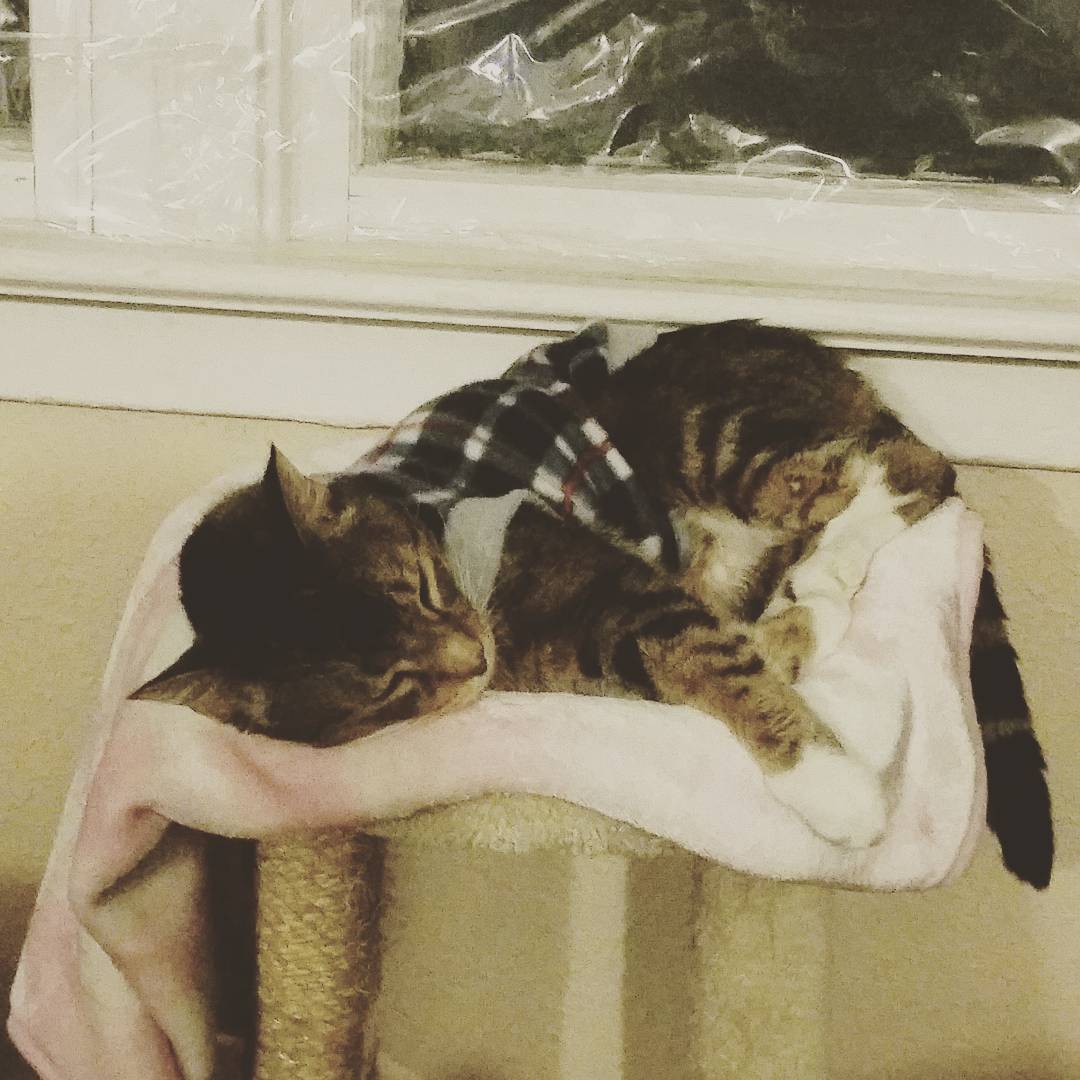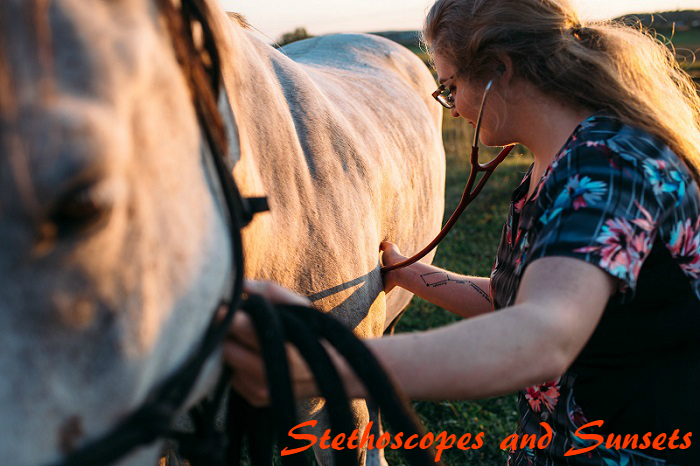
[My beautiful senior Rupert, whose massive size didn’t stop him from trying to cram himself into the smallest beds possible. Padding (and a sweater for old, cold bones) helped a little.]
As the standard of pet care and the knowledge of veterinary medicine both grow with leaps and bounds, we’re seeing pets begin to live longer and longer lives. Our sweet seniors are no different than people as they age; the organic machinery of bodies begins to wear out and break down no matter how hard we work at supporting and repairing what we can. The golden years of our pets can be an uncertain time and one full of hard decisions, but it can also be some of the best times of our lives together — and a time when you can give back to your best friend all that they’ve given to you. As Cicero wrote, “Old age: the crown of life, our play’s last act.”
There is something beautiful about an old pet. Nothing makes me smile quite like than the graying muzzle of an elderly pittie whose plaid jacket keeps the winter’s chill from her bones, or the self-satisfied look of a cat who’s put aside the mousing and playtime in favor of evenings spent by the fire, letting the younger generation take over their duties. I love listening to owners talk about the years they’ve spent with their friends, the ups and downs they’ve seen together. I frequently run into couples who have at least one pet who predates the relationship, sometimes by several years. My old fosters hold particularly special places in my heart and my last three cats, while not ancient, have certainly not been young. And although I’ll deny until the ends of the earth that I ever dare to have favorite patients — I have favorite patients, and they are all of them firmly settled in the ‘geriatric’ camp.
It is important to remember that for our pets, age is truly just a number. The life expectancy of a small dog is generally considerably longer than that of a large dog, and breeds all have their own particular lifespans. Cats are for the most part much longer-lived than dogs but breed and lifestyle can both change that easily. The idea of ‘dog years’ and ‘cat years’ aren’t quite as accurate as we’d like to think! With that said, it’s more important than ever to carefully monitor our pets for some of the pitfalls of old age which may come earlier or later than we might have thought.
Just like people, pets get old bones. Arthritis and joint disease are common in dogs, especially larger breeds or animals who have been extremely active in their youth. Previous injuries may come back to haunt them as well. Being overweight is a high risk factor for arthritis and once it develops, it can be extremely hard to get the weight off as your pet may not be able to move or exercise as they once did. Keeping your pet fit and lean can lower the risks, as can giving some approved joint supplements. Keep an eye out for symptoms such as reluctance to climb stairs or jump in/out of vehicles, being slow to rise or sit, poor exercise tolerance, lameness, crying out when touched or guarding certain areas, or even just ‘slowing down’. Although arthritis symptoms may be more discreet in cats that doesn’t mean that they’re not painful as well; affected cats may sleep even more than they already do, avoid jumping up and down, develop overgrown nails from reluctance to stretch and scratch, stop using vertical scratching surfaces, or even potentially have inappropriate urination or defecation if they’re uncomfortable reaching a litter box down a flight of stairs. All of these signs should be reported to a veterinarian, who can help develop a plan with you for pain control and dietary options to help your pet feel the best they can feel.
Yearly or even twice yearly exams should be a must! When we see a pet every day, it’s surprisingly easy to miss subtle changes that someone else’s trained eyes may pick up on. Your veterinarian can monitor your pet’s weight and general health as well as any ongoing medical conditions which may be present. Even if your animal has lived with a chronic condition such as thyroid dysfunction or heart disease their whole life, as they age their body may respond differently to medication or conditions may worsen. Bloodwork (plus or minus a urine analysis) is also strongly recommended once yearly. Performing a geriatric bloodwork panel on a pet can identify issues before they even start to manifest physically, allowing for quick treatment and often a better outcome. A typical geriatric panel includes a CBC (complete blood count) which looks at the amount of red and white cells in the blood as well as identifying any changes to the cells themselves, and a blood chemistry, which looks at the function of various organs such as the liver and kidneys to identify any dysfunction. Kidney disease in cats in particular is a silent killer, not showing symptoms until it is extremely advanced, but early kidney insufficiency can be found in routine blood screening and help to prolong the life of your pet. Urine analysis may also be recommended to take a deeper look at kidney and bladder health, as well as rule out the possibility of stones.
Apart from obvious health concerns, it’s important as your pet ages to adjust your lifestyle to accommodate for them. A dog who’s been allowed on the couch their whole life may be discouraged and unhappy when it realizes it can’t jump up anymore; consider ramps or steps (or even just spending more time down on the floor at their level). Those 20k mountain hikes might not be in the cards anymore; consider shorter walks or more gentle routes. Just like older people, older animals may need a little additional fiber in their diet to help with regularity — and the diet itself should be appropriate for old, potentially missing teeth. Available beds may need a little extra padding, and access to warmth should be easy. A pet who’s having a harder time getting outside to do their business should be given a little extra time or an area inside where they can relieve themselves. It’s up to us to make their lives easier.
But above all, cherish your pet. It is perhaps one of the great injustices of the world that our pets do not live as long as us, and I often hear friends, family, and clients expressing sadness as they watch their pet aging and slowing down. For all our advances in veterinary medicine, there is nothing we can do to halt the process of aging. We can help with the symptoms — pain control and supplements for old, dry joints, mind games for the creeping forgetfulness, medication for incontinence or loss of appetite — but in the end, comfort, not cure, is all we are able to offer. It can be easy to get hung up on this particularly as pets approach the end of their time with us, to spend our time dreading the final days or mourning the loss of energy, the stiffness in the mornings, the reluctance to do the things they once loved. It is difficult to see. It is painful for them, in the moment, and it is painful for us as we watch them and can’t help to compare to the young, bright, energetic bundle of fur they once were.
I’m not here to tell you not to feel that way. Grief, loss, anxiety, fear, and even anger are all natural emotions associated with caring for aging animals and it is important to recognize and allow yourself to feel these emotions. But it is equally important to cherish them while they are still with us. Like an elderly member of our own families, their bodies tell the stories of the years they’ve spent at our side, the comfort and companionship they have given us. Those eyes may not see quite as far as they once did but they still look up at us with love, trusting as as the steady point of their changing world. They may move more stiffly, but the happiness they feel as they walk through spring grass at our side is the happiness they have given back to us tenfold every day that they’ve been on this earth. They may sleep more, but their dreams are of the adventures we took together, the mountains climbed, the toys chewed and the treats eaten and the faces licked, the tears and the laughter, the good and the bad, the memory of two hearts as one.
Cherish your senior pets as they cherish you and take each day as the gift it truly is, time spent with a dear friend in the twilight of their life.

One comment
Wow! Thiis boog looks just like my oldd one! It’s
on a comnpletely different topoic but it has pretty much thhe same
layout and design. Excellent choice off colors!